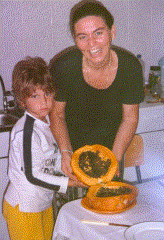Nigel J. Ross
Travelogue

* clicking on asterisked pictures takes you to a large-size photo
The trip to Cape Verde was a very last-minute decision, and we only actually booked the flights two days before leaving. A friend and former student who lives in Cape Verde kindly (and very judiciously) organised things there.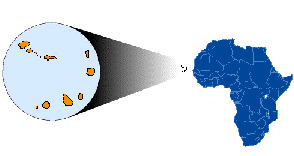 The Cape Verde Archipelago
The Cape Verde Archipelago
It was a real race to leave on the Friday evening. There was work to hand in before leaving, and after burning the midnight oil on Thursday night, it was eventually finished it at lunch time on the Friday. After all the other chores, we had about 20 minutes to pack! However, we managed to get to the airport on time ... just!
We left on the early evening flight for Lisbon, where we changed and flew to the island of Sal in the Cape Verde archipelago. We arrived a bit after 2 o'clock in the morning (4 o'clock Italian time), so we were quite tired, and ready to go straight to the little hotel that had been booked for us near the airport. However, we hadn't bargained for having to wait a good while to go through passport control, collect our bags, and - the longest wait of all - to get our visas. All of this took another two hours, so it was getting on for 5 in the morning (7am Italian time) before we eventually got to bed, absolutely shattered.
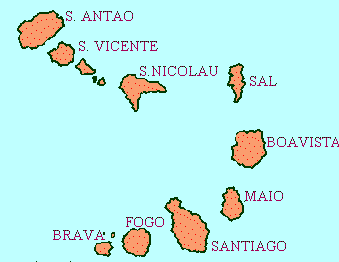 The nine inhabited islands in Cape Verde
The nine inhabited islands in Cape Verde
We had most of the next day on the island of Sal, though we slept in till lunchtime! Sal is a long, thinnish island - about 30 km long - mostly very flat and covered with a brown, rocky desert. It was the ideal location to build the international airport, and its other claim to fame is a wonderful 18 km-long tropical white sand beach (now lined with hotels and holiday villages). We spent a couple of hours in the afternoon visiting the salt flats - which have given the island its name. The salt flats lie in an extinct volcanic crater near the sea, where water collects and evaporates away, providing the salt.
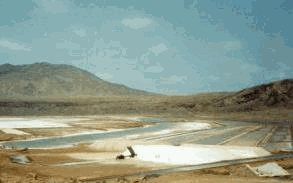 The salt flats on the island of Sal
The salt flats on the island of Sal
It was fascinating to sea the various basins, some full of brackish water, others in which the salt was beginning to form, and still others full of sea salt crystals. There was also a very primitive cable-car system to transport the salt out over the ridge of the crater. After a drink in a little bar at the seaside, we headed back to the airport for the late afternoon flight to the island Sao Vicente.
Cape Verde comprises nine inhabited islands, a couple of large uninhabited islands and numerous smaller islets. They are called the "Cape Verde" islands because they lie off Cape Verde in Senegal, the most westerly point of the African continent - not because they are very verdant (save a couple of exceptions). We visited three of the islands - Sal, where we arrived and where most tourists stay at the beach, then Sao Vicente, and the most westerly island of all, Santo Antao. Sao Vicente is also where Silvia (a friend and former student of many years ago) now lives, so we were greeted at the airport by her husband (Paolo) who took us back into the town of Mindelo where they live. Mindelo is the main port in Cape Verde and the second largest "city" (it has 50,000 inhabitants). They'd found a small flat for Carla and I for a few nights, and while it was quite basic and not particularly clean, it was very central, and we thought it would do.
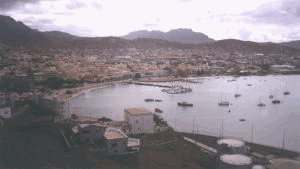 The town and port of Mindelo
The town and port of Mindelo
We went round to Silvia and Paolo's and then they took us out (with their 7-year old son, Leonardo) for a good meal. When we got back to our flat, however, we were not very happy to find that the whole building was pervaded with a disgusting smell of drains (or "sewers" to be more precise). We slept with the windows wide open, but when the smell was no better the next day, we decided to move elsewhere. So we went around the town looking for a suitable hotel. We looked at a few and eventually found one that we liked and so took our luggage across. Silvia and Paolo were very apologetic, but it was hardly their fault!
In the afternoon we took one of the "collective minibuses" out to a fishing village which has a couple of nice beaches. We thus got out first view of the island proper. It is quite hilly, volcanic and again rather desert-like. Although parts were fertile in the past, the droughts of the last 30 years (mainly due to global warming) mean that there is very little vegetation anywhere now. However the local population survive through imports from two other more fertile islands, from Portugal (Cape Verde was a Portuguese colony until 30 years ago) and food aid from the US and Europe. It was quite breezy at the beach, and the sea was rough, but we enjoyed just sitting on the spectacular beach and relaxing.
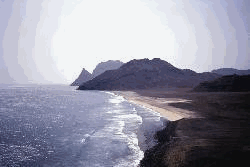 The coastline of Sao Vicente
The coastline of Sao Vicente
That evening, after in a dinner in a restaurant that seemed as if it had not changed since it was built by the Portuguese colonisers a century or so ago, we went to a concert of local music - something of a cross between Brazilian, Jamaican and Portuguese sounds.
The next day, unbelievingly, we awoke to the sound of rain. It was the first time it had rained in Feburary in 30-odd years, we were later told, the usual rainy season being late August and early September ... though the annual rainfall is just a few inches normally. It was still warm (most days between 25-30 degrees) and so it was fun looking round Mindelo between showers in the morning. The fruit market and the fish market were eye-openers (the latter also being a bit of a "nose-opener"). Some of the papayas in the fruit market were as big as footballs! We looked around the port a bit, did some shopping and so on. In the afternoon, however, we mainly stayed indoors as it rained quite heavily every time we planned to go out, though by the evening it had faired up. A long power cut meant that we had little choice of where to eat our evening meal that night - we went to one of the two "posh" hotels in the town, which has its own power supply!
We had planned to leave Sao Vicente the next morning, but delayed our departure to the afternoon ferry so that we could look around Mindelo a bit further, go to the bank and do other bits and pieces, after the rain had "washed out" such plans the day before. However, we discovered there was no afternoon ferry to Santo Antao that afternoon, so eventually we left on the Wednesday morning. It gave us the opportunity to see a bit more of Mindelo and take things easy, though more time on Santo Antao would have been very welcome.
On the Wednesday we got the 8 o'clock ferry boat which plies the straights between the two islands, taking a bit over an hour to do the crossing. The poor little boat was a mass of people and goods, and at times it seemed like a miracle that it stayed afloat! On arriving at Santo Antao, we straightway took a "collective minibus" across to the other side of the island, to the pretty little fishing village, Ribiera Grande, where we were staying.
The northern side of the island is the most beautiful and also quite green. After checking into the hotel, we set off on a long walk along the north-east coast. It is a spectacular coastline, with tall rugged cliffs, black beaches and crashing waves. We stopped for a long while in Ponta do Sol, a fishing village where we saw the days' catch being brought in, gutted and sold to the locals on the beach. We then walked a little more inland to a picturesque little hamlet in a narrow valley. We walked back the same way, reckoning we'd covered about 12 km in all. The little restaurant where we ate that night was quite good, but the wait for the food was even longer than the usual three-quarters of an hour! Life tends to have a very leisurely pace in Cape Verde, and there is little chance of doing anything in a hurry! The fresh fish we tasted on Santo Antao really deserves a description all of its own, and we particularly enjoyed the fresh tuna, sawfish and grouper.
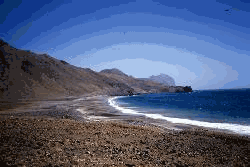 The Santo Antao coastline
The Santo Antao coastline
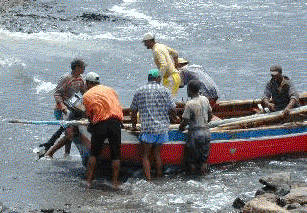 The catch comes in
The catch comes in
The next day we walked inland, along the Ribiera Grande (the large torrent - or rather its wide, dry bed) in a deep valley. After about four kilometers, we began to climb out of the valley, winding our way up between little villages and banana plantations. As we climbed higher, the vegetation changed to wild, uncultivated areas, mainly covered with yellow-flowering aloe vera and agave. Many agave had also "flowered", some with truly enormous tree-like "flower-stems" covered with small bulbs that would then be blown off to make for new plants. Some parts of the path were littered with these bulbs and we got quite a few to bring back. It was a breathtaking climb in all senses. We climbed up to about 700 metres (2000 feet) with wonderful views all around, eventally reaching a bit of a plateau, a village where we had some refreshments, and the main road to take us back to Ribiera Grande. The main road wound its way for quite a distance along a spiky crest, and so again spectacular views were the order of the day. Late in the evening - after about 20 kilometres of walking - we were back in our hotel, tired, stiff-legged but very satisfied (and very ready for another meal of fresh local fish, this time in a better restaurant).
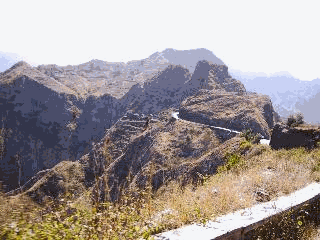 Santo Antao, the road running along the crest
Santo Antao, the road running along the crest
The last day, suffering a bit from stiff legs, we took a taxi up to one of the highest points of the island, the crater of an extinct volcano at around 1000 metres (3000 ft). We walked down into the crater which is quite fertile and cultivated. On the mule tracks we were following we were passed - rather too closely at one point - by a group of bulls and a number of donkeys carrying water. Climbing out of the crater at the other side, we were met with a superb view. We could look down the whole length of a very rugged, steep, narrow, green valley, all the way down to the sea, about 9 kilometers away. And this was the route we were to take. The first part was a very steep windy path through rough vegetation, but soon the terraces and plantations started. At first it was mainly sugar cane, but then there were terraces of fuit trees, banana trees in the main, but also papaya trees and bread-fruit trees. There were also some coffee bushes, and vegetables - mainly cabbages and carrots (which we were served nearly every day in the restaurants).
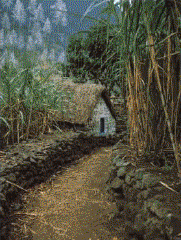
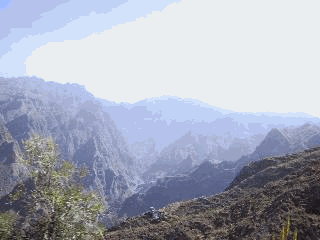 Typical views of Santo Antao
Typical views of Santo Antao
The walk took us through various villages, some quite poor and very "African", others with a few colonial influences. In the countryside, people are still quite poor, living in stone or mud huts with thatched rooves. The population is mainly made up of slaves who escaped here from passing boats, or from slaves brought here to work the land, mixed with Portuguese colonisers. As the islands were totally uninhabited until the late 15th century, there is no "original" culture. After the long downhill walk, in the late afternoon we eventually got to the coast, where we had a drink and then found an open "collective minibus" - a pick-up truck with benches in the back - for a rather fast, breezy ride back along the coastal road to Ribiera Grande.
 Capoverdian children
Capoverdian children
The next morning I left Carla, taking the minibus at 8 o'clock, and started my return journey (there was no way we could return together as there was only one return seat left on the plane to Portugal that evening, so Carla willingly decided to stay on an extra few days). I got to the port on the other side of the island about 9:30 and then took the 11 o'clock ferry back to Sao Vicente. This time the ferry was even more heavily burdened and there was a strong swell and wind. It was certainly no fun being tossed around in the little ship for an hour and a half, with one moment when it almost appeared to be keeling over. It was good to get into the port at Mindelo. I headed straight to Silvia's where I was treated to a delicious lunch (fish of course), and the biggest papaya I've ever seen.
Before very long it was time to head out to the airport to fly back to Sal. After checking in, Silvia took me for a short walk to the nearby bay of San Pedro, for a walk along the beach rather than waiting for over an hour in the airport.
Bay of San Pedro, Sao Vicente (with Silvia)* I had a long wait in Sal, so took a taxi (the prices are pretty cheap there) to a picturesque little port nearby where I walked around a bit and then had a meal. I'd been fortunate in being with Carla all of the time up until then, as she speaks a bit of Portuguese, though most people in restaurants or hotels speak some Spanish or French, sometimes English. But in this little restaurant, the waitress only spoke Portuguese - or the local Portuguese creole, I guessed. Somehow, trying to mimic what I'd heard Carla say, mixed with a jumbled bit of Spanish and French, I managed to get quite a nice meal, though along with the sweet potatoes, I again got carrots and cabbage as vegetables which I'd wanted to avoid! Back to the airport, I checked in at about 11:30 pm, the departure time being 2 o'clock in the morning. But we didn't actually leave till nearly 4 o'clock, which meant that I missed my connection in Lisbon. It was chaos at Lisbon airport on Sunday morning, with long, long queues of people having missed their connections and tempers rising at the transit desks. I waited nearly two hours to be re-routed, and was eventually sent to Milan with a change in Madrid. As a result, it was after 7 o'clock when I got back to Milan airport, only to find - as I'd just about expected - that my luggage hadn't managed to follow me! It was after 8 o'clock when I eventually got home, having been travelling on and off for about 36 hours, and having just managed about 3 hours sleep on the plane from Cape Verde to Lisbon. Shattered, but still very pleased to have had such a fascinating holiday. Two days later I had a phone call from Milan Malpensa airport saying they'd found my luggage and it was delivered in the early evening! A relief to end a wonderful holiday! Carla got back four days later, and she too remains full of enthusiasm for the islands, truly a unique place!
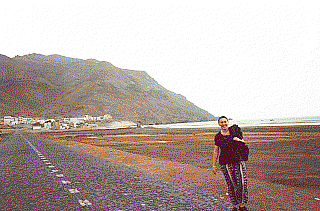
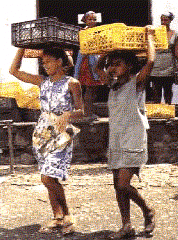 The Capoverdian way of carrying things!
The Capoverdian way of carrying things!
Home |
Publications |
Dictionaries |
English Lang. |
Art Insights |
Travel |
Links | ||||||
